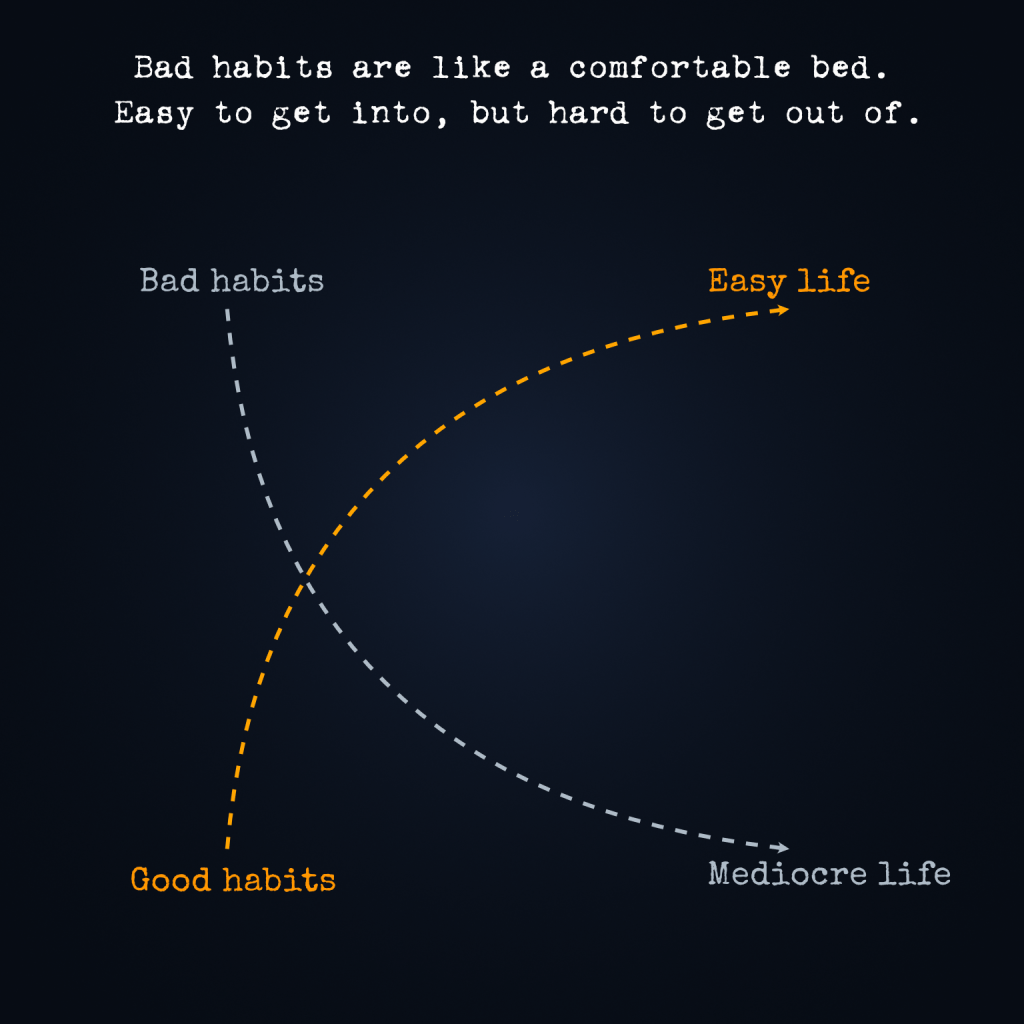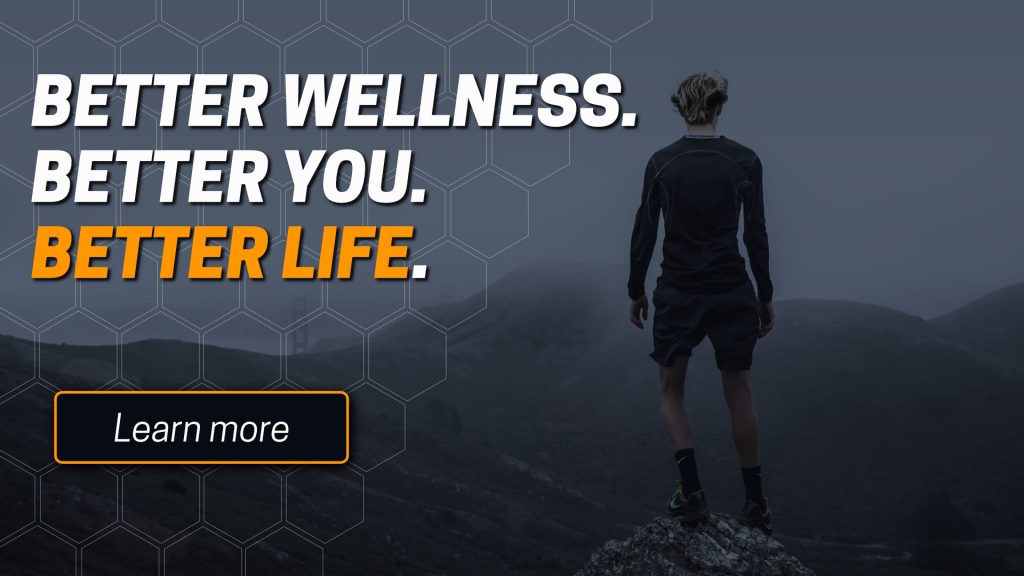Today at a Glance
- Most people replace a bad habit with another bad habit.
- Most of your bad habits are caused by two things…
- All the habits you have right now, whether good or bad, serve a purpose in your life.
- How to ditch a bad habit actually
- How you can start today

Most people replace a bad habit with another bad habit.
Instead of lighting up a cigarette, they open a Snickers bar.
Instead of binge-watching another Netflix series, they work a few more hours.
Instead of getting hammered in the club at weekends, they’d have a few more drinks at the business dinner.
But they still jeopardize their health — both mentally and physically.
So why do we still do them? And most importantly, is there anything you can do about it?
Making changes in the real world needs intentional practice. So how can you ditch your bad behaviors and stick to good ones instead?
We certainly don’t have all the answers, but keep reading and we’ll share what we’ve learned about how to break a bad habit (and what has worked for us as well as clients).
"Your net worth to the world is usually determined by what remains after your bad habits are subtracted from your good ones."
— Benjamin Franklin
The root causes of bad habits
Most of your bad habits are caused by two things…
Stress and boredom.
Often, bad habits are a shortcut for dealing with stress and boredom.
I remember vividly how I went out and lit a cigarette every hour (which is more than an hour of wasted time every day btw). Also wasting time on the internet can be a simple response to stress and boredom.
But hey, it doesn’t have to be like that. You can teach yourself new, healthy ways to handle stress and boredom, and then swap those bad habits for some good ones.
It’s important to recognize that the stress or boredom we experience on the surface may stem from deeper issues. To truly make changes, we must be honest with ourselves.
Are there any reasons, fears, events, or limiting beliefs causing you to hold on to something bad for you?
Once you understand the root cause(s), you can overcome these habits and align your actions with our purpose.
You don’t ditch a bad habit, you replace it
All the habits you have right now, whether good or bad, serve a purpose in your life. They provide some form of benefit, even if they harm you in other ways.
Sometimes the benefit is biological, like smoking or drugs. Sometimes it’s emotional, like staying in a toxic relationship. And often, bad habits become a way to cope with stress. For instance, eating sweet snacks, or checking your phone.
These bad habits, no matter how small, serve a purpose in your life. That’s why simply trying to eliminate them rarely works. Instead, the key is to replace them with healthier habits that fulfill the same need.
For example, if you turn to smoking when you’re stressed, it’s not effective to just tell yourself to quit. Instead, find a different way to manage stress and make that your new go-to habit.
What worked for me, was still going outside (same habit) but instead of lighting up a cigarette, I inhaled deeply and profoundly the fresh air (new habit).
How to ditch a bad habit
1. Identify your next bad habit to ditch
Make a list of your current habits — both good and bad.
Then identify the top 3 habits you want to change (and the new habits you want to cultivate).
Start with the top number 1.
You want to have a plan for how you will respond when you face the stress or boredom that prompts your bad habit. What are you going to do when you get the urge to smoke? (Example: breathing exercises instead.)
2. Understand your triggers
Identify the triggers or cues that lead to your bad habits. Recognize the situations, emotions, or stressors that prompt the habit.
For instance, I’d smoke when I drank so I stopped going to the bar. If you eat cookies when they are in the drawer at your desk, then throw them all away (and don’t buy new ones).
To make it easier to break a bad habit, avoid the things that trigger it.
3. Join forces with somebody
How often do you try to be more active in private? Or maybe you “quit smoking” … but you kept it to yourself? (That way no one will see you fail, right?) That’s self-betrayal. You’re just keeping the back door open.
The better way: pair up with someone and quit together. When you team up with someone, you’ve got a built-in accountability partner. You can keep each other on track, celebrate those wins together, and push each other to be your best.
Surround yourself with people who live the way you want to live. You don’t need to break up with your old friends, but there’s power in finding some new ones.
We’ve created a community for High-Energy Habits to own your morning so that you can own your day. Check it out here.
4. Visualize yourself succeeding
Imagine yourself ditching the cigarettes or grocery shopping healthy food or waking up early. Whatever bad habit you are trying to break, envision yourself entirely overcoming it, smiling, and enjoying your success. See yourself building a new identity.
You don’t need to be someone else, you just need to break the habit of being you.
When we tell people they need to create a new identity, they think they need to become an entirely new person. But the truth is that you already have it in you to be someone without your bad habits.
Here’s in the words of a former client of ours:
“I stopped eating unhealthy food by transforming my identity,” he said. “In the past, I tried many times, but it only became effortless and natural after I consciously decided to become someone who lives a healthy lifestyle. Instead of aiming for I want to stop eating bad food, I shifted my mindset to I am someone that eats healthy and lives a healthy life. This perspective shift changes how you approach things.”
5. Bounce back from setbacks
Even the best of us slip up from time to time.
When you screw up, it doesn’t make you a bad person. It makes you human. Welcome to the club. Instead of beating yourself up over a mistake, plan for it. The key to sustainable success is getting back on track quickly, just like top performers do.
Start with awareness
The first step to breaking bad habits: start with awareness.
It’s important to focus on making meaningful change rather than getting caught up in how you feel about your bad habit or wishing for things to be different. Awareness will show you how to actually evolve.
- What triggers the behavior and causes it to start?
- When does your bad habit actually happen?
- How many times do you do it each day?
- Where are you?
- Who are you with?
Here’s a simple way to start: just track how many times per day your bad habit happens. Use the Notes app on your phone and type an X every time you do your bad habit. At the end of the day sum up the Xs. More accurate is doing this an entire week, counting the total and dividing it by 7. So it includes weekends and you know your average.
The thing about mindful awareness is that you don’t beat yourself up or feel guilty about doing something unhealthy or unproductive. The only goal is to be aware of when it happens and how often it happens. Then you start with implementing tiny changes and replacing one thing after the other. You got this.
That’s it for today.
Hope you enjoyed it (and learned something new).
As always, stay fit, stay active, and enjoy your life.
Ketty & Markus








